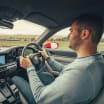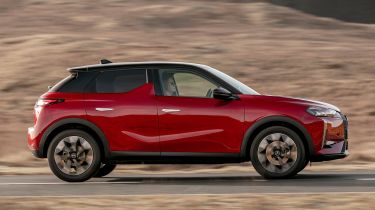DS 3 E-Tense review: performance, motor & drive
The DS 3 E-Tense is refined, relatively comfortable and has enough power for pottering around town
| 0-62mph | Top speed | Driven wheels | Power |
|---|---|---|---|
| 9.0s | 93mph | Front | 154bhp |
On the road, the DS 3 E-Tense’s powertrain is the main highlight. Put your foot down and the instant surge associated with so many electric cars is present and correct. It’s not Tesla quick, but the DS builds power fast enough to keep up with swiftly moving traffic. In fact, the slightly softer throttle response makes it very relaxing to drive.
It’s impressively refined, even at motorway speeds – with little in the way of motor whine, wind or road noise. Around town, only poor rearward and over-the-shoulder visibility let it down, with light and accurate steering making it easy to position and manoeuvre. Raise your speed and you’ll find that while the DS isn’t the most entertaining small crossover, it does feel safe and predictable.
DS 3 E-Tense 0-62mph, top speed and acceleration
The DS 3’s powertrain got updated in 2022 with a bigger 54kWh battery and 154bhp electric – up from 134bhp before. The extra power means 0-62mph still takes around nine seconds and will go onto an electronically limited top speed of 93mph. While that may not sound much, it’s unlikely to trouble too many buyers – in the UK at least. We did find the electric motor ran out of puff a bit at higher speeds, but no more so than you experienced in the Kia Niro EV – just as long as you steer clear of the DS’s Eco mode which limits the motor’s power output.
Handling
The electric DS 3 is at its best around town. It’s comfortable, easy to drive and has enough power on tap for manoeuvring through city traffic. The well-judged regenerative braking set-up doesn’t offer one-pedal driving like a Niro EV, but it's progressive and contributes to the relaxing driving experience. Parking could be made easier if visibility was better, but at least some versions get a reversing camera.
As before, the DS 3 is decent on the motorway, too, because of the smooth ride and excellent levels of refinement. Even at 70mph the cabin is quiet with very little wind or road noise filtering in. It’s not the most fun electric car to drive, however. Where the DS 3 feels composed and secure on wide, open roads, it’s a little looser through tight bends and you’ll find the limits of the available grip much quicker than in, say, a Cupra Born or MG4 EV.

